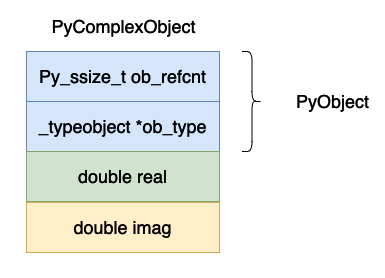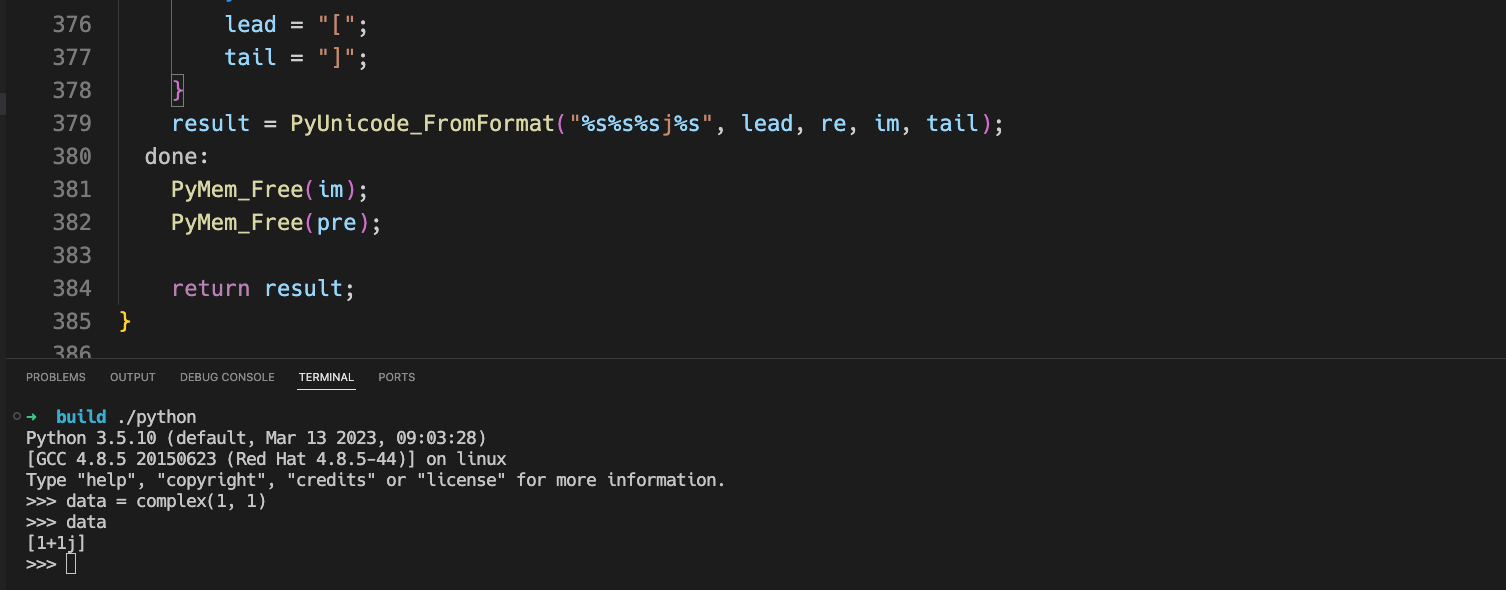- Java锁的逻辑(结合对象头和ObjectMonitor)
- 还在用饼状图?来瞧瞧这些炫酷的百分比可视化新图形(附代码实现)⛵
- 自动注册实体类到EntityFrameworkCore上下文,并适配ABP及ABPVNext
- 基于Sklearn机器学习代码实战
在本篇文章当中主要给大家介绍在 cpython 虚拟机当中是如何实现 复数 complex 这个数据类型的,这个数据类型在 cpython 当中一应该是一个算比较简单的数据类型了,非常容易理解.
在 cpython 当中对于复数的数据结构实现如下所示:
typedef struct {
double real;
double imag;
} Py_complex;
#define PyObject_HEAD PyObject ob_base;
typedef struct {
PyObject_HEAD
Py_complex cval;
} PyComplexObject;
typedef struct _object {
_PyObject_HEAD_EXTRA
Py_ssize_t ob_refcnt;
struct _typeobject *ob_type;
} PyObject;
上面的数据结构图示如下:

复数的数据在整个 cpython 虚拟机当中来说应该算是比较简单的了,除了一个 PyObject 头部之外就是实部和虚部了.
ob_refcnt,表示对象的引用记数的个数,这个对于垃圾回收很有用处,后面我们分析虚拟机中垃圾回收部分在深入分析.
ob_type,表示这个对象的数据类型是什么,在 python 当中有时候需要对数据的数据类型进行判断比如 isinstance, type 这两个关键字就会使用到这个字段.
real,表示复数的实部.
imag,表示复数的虚部.
下面是 cpython 当中对于复数加法的实现,为了简洁删除了部分无用代码.
static PyObject *
complex_add(PyObject *v, PyObject *w)
{
Py_complex result;
Py_complex a, b;
TO_COMPLEX(v, a); // TO_COMPLEX 这个宏的作用就是将一个 PyComplexObject 中的 Py_complex 对象存储到 a 当中
TO_COMPLEX(w, b);
result = _Py_c_sum(a, b); // 这个函数的具体实现在下方
return PyComplex_FromCComplex(result); // 这个函数的具体实现在下方
}
// 真正实现复数加法的函数
Py_complex
_Py_c_sum(Py_complex a, Py_complex b)
{
Py_complex r;
r.real = a.real + b.real;
r.imag = a.imag + b.imag;
return r;
}
PyObject *
PyComplex_FromCComplex(Py_complex cval)
{
PyComplexObject *op;
/* Inline PyObject_New */
// 申请内存空间
op = (PyComplexObject *) PyObject_MALLOC(sizeof(PyComplexObject));
if (op == NULL)
return PyErr_NoMemory();
// 将这个对象的引用计数设置成 1
(void)PyObject_INIT(op, &PyComplex_Type);
// 将复数结构体保存下来
op->cval = cval;
return (PyObject *) op;
}
上面代码的整体过程比较简单:
复数取反操作就是将实部和虚部取相反数就可以了,这个操作也比较简单.
static PyObject *
complex_neg(PyComplexObject *v)
{
Py_complex neg;
neg.real = -v->cval.real;
neg.imag = -v->cval.imag;
return PyComplex_FromCComplex(neg);
}
PyObject *
PyComplex_FromCComplex(Py_complex cval)
{
PyComplexObject *op;
/* Inline PyObject_New */
op = (PyComplexObject *) PyObject_MALLOC(sizeof(PyComplexObject));
if (op == NULL)
return PyErr_NoMemory();
(void)PyObject_INIT(op, &PyComplex_Type);
op->cval = cval;
return (PyObject *) op;
}
我们现在来介绍一下一个有趣的方法,就是复数类型的 repr 函数,这个和类的 __repr__ 函数是作用是一样的我们看一下复数的输出是什么:
>>> data = complex(0, 1)
>>> data
1j
>>> data = complex(1, 1)
>>> data
(1+1j)
>>> print(data)
(1+1j)
复数的 repr 对应的 C 函数如下所示:
static PyObject *
complex_repr(PyComplexObject *v)
{
int precision = 0;
char format_code = 'r';
PyObject *result = NULL;
/* If these are non-NULL, they'll need to be freed. */
char *pre = NULL;
char *im = NULL;
/* These do not need to be freed. re is either an alias
for pre or a pointer to a constant. lead and tail
are pointers to constants. */
char *re = NULL;
char *lead = "";
char *tail = "";
// 对应实部等于 0 虚部大于 0 的情况
if (v->cval.real == 0. && copysign(1.0, v->cval.real)==1.0) {
/* Real part is +0: just output the imaginary part and do not
include parens. */
re = "";
im = PyOS_double_to_string(v->cval.imag, format_code,
precision, 0, NULL);
if (!im) {
PyErr_NoMemory();
goto done;
}
} else {
/* Format imaginary part with sign, real part without. Include
parens in the result. */
// 将实部浮点数变成字符串
pre = PyOS_double_to_string(v->cval.real, format_code,
precision, 0, NULL);
if (!pre) {
PyErr_NoMemory();
goto done;
}
re = pre;
// 将虚部浮点数变成字符串
im = PyOS_double_to_string(v->cval.imag, format_code,
precision, Py_DTSF_SIGN, NULL);
if (!im) {
PyErr_NoMemory();
goto done;
}
// 用什么括号包围起来
lead = "(";
tail = ")";
}
result = PyUnicode_FromFormat("%s%s%sj%s", lead, re, im, tail);
done:
PyMem_Free(im);
PyMem_Free(pre);
return result;
}
我们现在修改源程序将上面的 () 两个括号变成 [],编译之后执行的结果如下所示:

可以看到括号变成了 [] .
在本篇文章当中主要给大家介绍了在 cpython 虚拟机当中对于复数这一类型的数据结构以及他的具体实现。总体来说这个数据结构比较简单,操作也相对容易,比较容易理解,最后简单介绍了一下复数类型的 repr 实现,其实这个函数和 python 的类型系统有关,目前我们还没有仔细去讨论这一点,在后续的文章当中我们将深入的去学习这个知识点,现在我们就先了解其中部分函数即可.
本篇文章是深入理解 python 虚拟机系列文章之一,文章地址: https://github.com/Chang-LeHung/dive-into-cpython 。
更多精彩内容合集可访问项目: https://github.com/Chang-LeHung/CSCore 。
关注公众号:一无是处的研究僧,了解更多计算机(Java、Python、计算机系统基础、算法与数据结构)知识.
最后此篇关于深入理解Python虚拟机:复数(complex)的实现原理及源码剖析的文章就讲到这里了,如果你想了解更多关于深入理解Python虚拟机:复数(complex)的实现原理及源码剖析的内容请搜索CFSDN的文章或继续浏览相关文章,希望大家以后支持我的博客! 。
本文全面深入地探讨了Docker容器通信技术,从基础概念、网络模型、核心组件到实战应用。详细介绍了不同网络模式及其实现,提供了容器通信的技术细节和实用案例,旨在为专业从业者提供深入的技术洞见和实
📒博客首页:崇尚学技术的科班人 🍣今天给大家带来的文章是《Dubbo快速上手 -- 带你了解Dubbo使用、原理》🍣 🍣希望各位小伙伴们能够耐心的读完这篇文章🍣 🙏博主也在学习阶段,如若发
一、写在前面 我们经常使用npm install ,但是你是否思考过它内部的原理是什么? 1、执行npm install 它背后帮助我们完成了什么操作? 2、我们会发现还有一个成为package-lo
Base64 Base64 是什么?是将字节流转换成可打印字符、将可打印字符转换为字节流的一种算法。Base64 使用 64 个可打印字符来表示转换后的数据。 准确的来说,Base64 不算
目录 协程定义 生成器和yield语义 Future类 IOLoop类 coroutine函数装饰器 总结 tornado中的
切片,这是一个在go语言中引入的新的理念。它有一些特征如下: 对数组抽象 数组长度不固定 可追加元素 切片容量可增大 容量大小成片增加 我们先把上面的理念整理在这
文章来源:https://sourl.cn/HpZHvy 引 言 本文主要论述的是“RPC 实现原理”,那么首先明确一个问题什么是 RPC 呢?RPC 是 Remote Procedure Call
源码地址(包含所有与springmvc相关的,静态文件路径设置,request请求入参接受,返回值处理converter设置等等): spring-framework/WebMvcConfigurat
请通过简单的java类向我展示一个依赖注入(inject)原理的小例子虽然我已经了解了spring,但是如果我需要用简单的java类术语来解释它,那么你能通过一个简单的例子向我展示一下吗?提前致谢。
1、背景 我们平常使用手机和电脑上网,需要访问公网上的网络资源,如逛淘宝和刷视频,那么手机和电脑是怎么知道去哪里去拿到这个网络资源来下载到本地的呢? 就比如我去食堂拿吃的,我需要
大家好,我是飞哥! 现在 iptables 这个工具的应用似乎是越来越广了。不仅仅是在传统的防火墙、NAT 等功能出现,在今天流行的的 Docker、Kubernets、Istio 项目中也经
本篇涉及到的所有接口在公开文档中均无,需要下载 GitHub 上的源码,自己创建私有类的文档。 npm run generateDocumentation -- --private yarn gene
我最近在很多代码中注意到人们将硬编码的配置(如端口号等)值放在类/方法的深处,使其难以找到,也无法配置。 这是否违反了 SOLID 原则?如果不是,我是否可以向我的团队成员引用另一个“原则”来说明为什
我是 C#、WPF 和 MVVM 模式的新手。很抱歉这篇很长的帖子,我试图设定我所有的理解点(或不理解点)。 在研究了很多关于 WPF 提供的命令机制和 MVVM 模式的文本之后,我在弄清楚如何使用这
可比较的 jQuery 函数 $.post("/example/handler", {foo: 1, bar: 2}); 将创建一个带有 post 参数 foo=1&bar=2 的请求。鉴于 $htt
如果Django不使用“延迟查询执行”原则,主要问题是什么? q = Entry.objects.filter(headline__startswith="What") q = q.filter(
我今天发现.NET框架在做计算时遵循BODMAS操作顺序。即计算按以下顺序进行: 括号 订单 部门 乘法 添加 减法 但是我四处搜索并找不到任何文档确认 .NET 绝对 遵循此原则,是否有此类文档?如
已结束。此问题不符合 Stack Overflow guidelines .它目前不接受答案。 我们不允许提出有关书籍、工具、软件库等方面的建议的问题。您可以编辑问题,以便用事实和引用来回答它。 关闭
API 回顾 在创建 Viewer 时可以直接指定 影像供给器(ImageryProvider),官方提供了一个非常简单的例子,即离屏例子(搜 offline): new Cesium.Viewer(
As it currently stands, this question is not a good fit for our Q&A format. We expect answers to be

我是一名优秀的程序员,十分优秀!